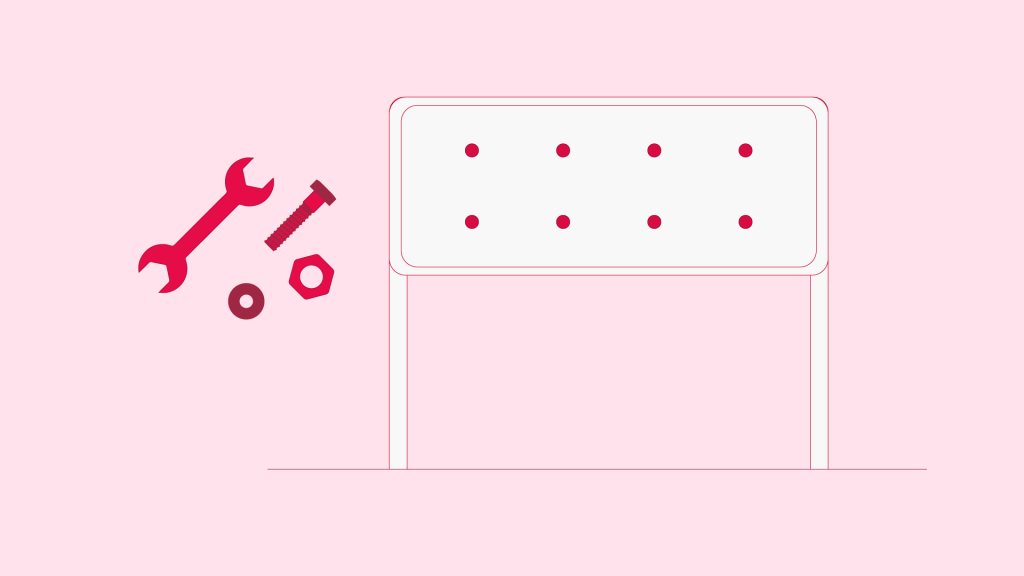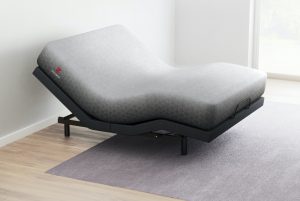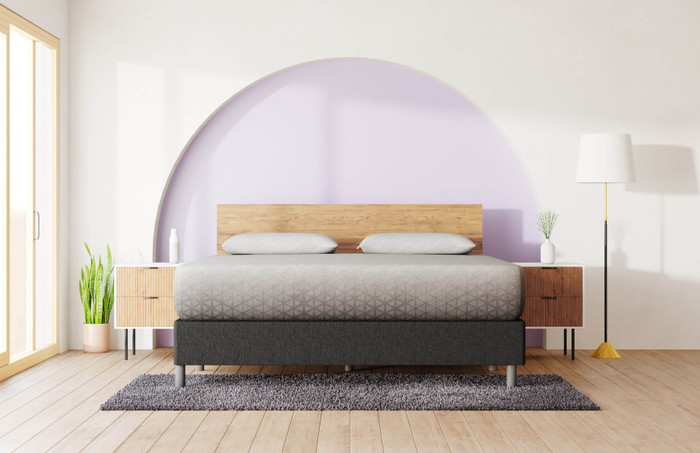How to Attach a Headboard to an Adjustable Bed Frame

Key Takeaways
- Headboard Attachment to Adjustable Bed Frames: Adding a headboard to your adjustable bed frame can enhance the aesthetics of your bed and protect your wall from damage. It’s essential to ensure compatibility between the headboard and the bed frame, choosing the appropriate headboard brackets for attachment.
- Installation Steps for Attaching a Headboard: Clearing the workspace, raising the head of the adjustable bed, and attaching the headboard brackets to the bed frame are fundamental steps in the installation process. Maintaining adequate clearance between the headboard and the bed frame is also necessary to avoid unnecessary friction or rubbing against the wall.
- Benefits of Adjustable Beds and Accompanying Accessories: Adjustable beds offer numerous benefits, including customizable comfort and relief from various health conditions such as sleep apnea, acid reflux, and back pain. Choosing a compatible mattress, such as memory foam, latex, or hybrid, is crucial to ensure optimal performance and longevity.
If you recently purchased an adjustable bed, you may be considering adding a headboard to add to your bed’s aesthetic. Using a headboard gives support to your bed, but it also most protects your wall against abrasion. This will pair perfectly with an adjustable bed designed to keep your spine in a neutral position.
Most modern headboards can be attached to an adjustable bed frame without any issues. However, you’ll still want to secure your headboard correctly to prevent damage. In this article, we’ll teach you how to attach a headboard to an adjustable bed frame.
Check the Bed Frame For a Headboard Bracket
First, you’ll want to check your headboard’s tool pack to see if it comes with headboard brackets. If your item does not come with brackets, you’ll need to buy a compatible bracket set. To find the most compatible brackets to your adjustable bed base, read the product description of the adjustable frame you purchased.
Once you purchase your headboard bracket kit, it will include all the proper nuts and bolts for you to attach to your headboard. Brackets are usually constructed with heavy-duty steel.
While you’re shopping, you may run into two types of bracket designs— “bolt-on” and “hook-on” designs. These designs will help determine how your headboard will be attached.
Look at the Type of Headboard Attachments
The next step is checking the headboard mount to see which type of attachment it needs. If your headboard attachment is a bolt-on bracket, it will feature drill holes. To install these brackets, you pass a bolt through the drill hole, slide the washer on, and secure it. Make sure the brackets are aligned correctly to secure the attachment properly.
Headboards with a hook-on design have slits where the hooks are attached. Hook-on designs are usually easier to attach. You’ll need to use the hook side to attach the brackets to your headboard.
Clear Your Workspace
Providing yourself with a clear workspace is an essential part of attaching a headboard to your frame. It may even be a good idea to rearrange your bedroom furniture or move your base to provide yourself with more workspace.
Clearing your bedroom will give you easy access to your headboard. We also suggest asking a friend to help you with attaching your headboard. A helping hand could make it easier to maneuver bulky bedroom items.
Raise the Head of the Adjustable Bed
Next, you’ll need to raise the head of the adjustable bed frame to have easy access to the front of the bed and your headboard kit. Like we mentioned above, rearranging your room or moving your bed away from the wall will make it easier to secure your attachment.
Attach the Headboard Brackets to the Frame
Now that you’ve cleared your workspace and raised your headboard, it’s time to attach it. Instructions will vary by manufacturer, but most guides will follow these steps:
- Fasten the headboard bracket channels to the bed frame, then attach the headboard flanges to the bracket channels.
- Next, slide the brackets 1.5-2 inches away from the edge of the bed to allow for clearance. This step will prevent your headboard from rubbing against your walls.
- Finish this process by tightening the bolts with a wrench to keep the bracket channels and flanges in place.
Secure the Headboard
Securing your headboard is the last step. Line up the headboard’s holes with the brackets, then stick the bolts through the holes. Be sure that at least 1.5 – 2-inches of space is left between the base and your headboard.
Best Adjustable Bed: Zoma Adjustable Bed
 If you’re looking for a super comfy adjustable bed, the Zoma Adjustable Bed is an excellent choice. The Zoma Adjustable Bed allows sleepers to upgrade their comfort with its various pressure-relieving positions. Plus, the price is unbeatable, with options as low as $840.
If you’re looking for a super comfy adjustable bed, the Zoma Adjustable Bed is an excellent choice. The Zoma Adjustable Bed allows sleepers to upgrade their comfort with its various pressure-relieving positions. Plus, the price is unbeatable, with options as low as $840.
Sleepers will be able to elevate their sleep with the Zoma Adjustable Bed and enjoy the endless benefits of adjustable beds. With near limitless customization, you’ll be able to save your favorite positions for sleep. There are also pre-programmed positions you can choose to enhance your comfort with just the click of a button. Try out presets like Zero-G and anti-snoring positions for greater restoration.
Are you looking to kick back after a long day? Treat yourself to a message using the adjustable bed’s full-body massage feature. This bed offers three intensity settings to keep you feeling relaxed from head to toe.
Another exciting feature of the Zoma Adjustable Bed is its ts zero-clearance design and detachable legs. This means the base does not have exposed moving parts beneath, allowing it to be set on any bed frame.
You’ll also benefit from features like under-bed LED lighting to keep you from stumbling in the dark at night. Not to mention, you can keep your phone charged up as the bed’s base lets you hook up your devices to charge while you sleep.
The Zoma Adjustable Base includes a 10-year warranty and free shipping with a purchase of an adjustable bed. Sleepers will also have access to a 100-night sleep trial if they choose to pair the base with a Zoma mattress.
Why Use An Adjustable Bed?
Aside from the potential for customizable comfort, the benefits of an adjustable bed also include relief from:
- Sleep apnea and snoring
- GERD and acid reflux
- Back pain
- Arthritis
- High blood pressure
- Diabetes
- Restless leg syndrome
What Else Does an Adjustable Bed Need?
When it comes to choosing the best mattress for an adjustable bed, you want to choose one that’s flexible enough to adapt with changes in elevation. We would recommend:
- Memory foam mattresses
- Latex mattresses
- Hybrid mattresses
For a simpler shopping experience, you may want to pick out an adjustable bed and mattress combo.
Once you have a mattress, you need to choose excellent sheets and other bedding, as well. Along with taking measures to keep the sheets in place on the adjustable bed, such as fasteners or velcro straps.
You can complete the headboard’s classic, upscale look by using a bed skirt with the adjustable bed.
FAQs
What mattress should I use with an adjustable bed?
Memory foam, latex, and hybrid beds usually work best with adjustable beds. These beds are pretty flexible, so their material will not become damaged when you adjust your beds. We do not recommend using an innerspring mattress with adjustable bases since its springs may break when repositioning your mattress.
Conclusion
Attaching a headboard should be pretty easy as long as you follow the proper procedure. Be sure to keep your workspace clear while attaching your headboard to prevent potential injuries from occurring.
Though headboards give your bedroom a luxurious look, they can be pretty bulky. You’ll want to consider the size of your room and the headboard before you make your purchase. If you buy a too large headboard, it could make your space feel a bit crowded.
This article is for informational purposes and should not replace advice from your doctor or other medical professional.
Sarah Anderson, Certified Sleep Science Coach 
Sarah Anderson is a sleep, health, and wellness writer and product reviewer. She has written articles on changing and improving your sleep schedule, choosing the right mattress for chronic pain conditions, and finding the best pillow for you. Sarah Anderson has her Bachelor of Arts degree from Arizona State University in Journalism and Mass Communications. Prior to working for Zoma, she wrote for a variety of news publications. Sarah's work has been featured on Bustle, PureWow, and other publications.
View all posts

